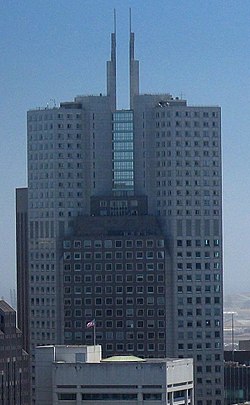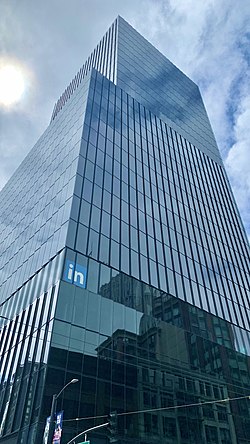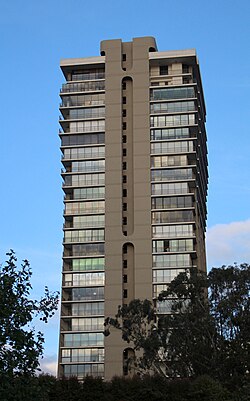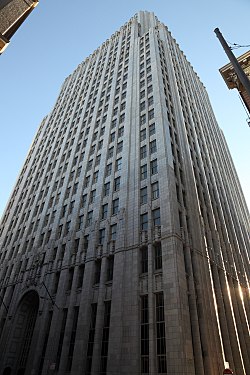Top Qs
Timeline
Chat
Perspective
List of tallest buildings in San Francisco
List of tallest buildings in San Francisco, California, United States of America From Wikipedia, the free encyclopedia
Remove ads
San Francisco is a major city in the U.S state of California. The broader San Francisco Bay Area has a population of up to 9.2 million residents as of 2023. San Francisco has over 480 high-rises,[1] 58 of which are at least 400 feet (122 m) tall. San Francisco has one of the largest skylines in the Western United States. It has the second most skyscrapers taller than 492 feet (150 m) in California and the Western U.S, with 26, after Los Angeles. The tallest building in the city is Salesforce Tower, a supertall skyscraper completed in 2018 at a height of 1,070 ft (326.1 m). It is the 18th-tallest building in the United States and the second tallest in California.
The city's second-tallest building is the Transamerica Pyramid, which rises 853 ft (260 m), and was previously the city's tallest for 45 years, from 1972 to 2017.[2] The city's third-tallest building is 181 Fremont, rising to 802 ft (244 m).
Remove ads
History
Summarize
Perspective
California's first skyscraper was the 218-foot (66 m) Chronicle Building in San Francisco, which was completed in 1890. M. H. de Young, owner of the San Francisco Chronicle, commissioned Burnham and Root to design a signature tower to convey the power of his newspaper.[3] Not to be outdone, de Young's rival, industrialist Claus Spreckels, purchased the San Francisco Call in 1895 and commissioned a tower of his own that would dwarf the Chronicle Building.[4] The 315-foot (96 m) Call Building was completed in 1898 and stood across Market Street from the Chronicle Building. The Call Building (later named the Spreckels Building, and Central Tower today) would remain the city's tallest for nearly a quarter century.
Both steel-framed structures survived the 1906 earthquake, demonstrating that tall buildings could be safely constructed in earthquake country.[5][6] Other early twentieth-century skyscrapers above 200 feet (61 m) include the Merchants Exchange Building (1903), Humboldt Bank Building (1908), Hobart Building (1914), and Southern Pacific Building (1916). Another skyscraper boom took hold during the 1920s, when several Neo-Gothic and Art Deco high rises, reaching three to four hundred feet (90 to 120 m) in height, were constructed, including the Standard Oil Building (1922), Pacific Telephone Building (1925), Russ Building (1927), Hunter-Dulin Building (1927), 450 Sutter Medical Building (1929), Shell Building (1929), and McAllister Tower (1930).[7]
The Great Depression and World War II halted any further skyscraper construction until the 1950s when the Equitable Life Building (1955) and Crown-Zellerbach Building (1959) were completed. Many of San Francisco's tallest buildings, particularly its office skyscrapers,[8] were completed in a building boom from the late 1960s until the late 1980s.[9] During the 1960s, at least 40 new skyscrapers were built,[10] and the Hartford Building (1965), 44 Montgomery (1967), Bank of America Center (1969), and Transamerica Pyramid (1972) each, in turn, took the title of the tallest building in California upon completion. At 853 feet (260 m) tall, the Transamerica Pyramid was one of the most controversial, with critics suggesting that it be torn down even before it was completed.[10]
This surge of construction was dubbed "Manhattanization" by opponents and led to local legislation that set some of the strictest building height limits and regulations in the country.[11] In 1985, San Francisco adopted the Downtown Plan, which slowed development in the Financial District north of Market Street and directed it to the area South of Market around the Transbay Terminal.[12] Over 250 historic buildings were protected from development and developers were required to set aside open space for new projects.[13] To prevent excessive growth and smooth the boom-and-bust building cycle, the Plan included an annual limit of 950,000 square feet (88,000 m2) for new office development, although it grandfathered millions of square feet of proposals already in the development pipeline. In response, voters approved Proposition M in November 1986 that reduced the annual limit to 475,000 square feet (44,100 m2) until the grandfathered square footage was accounted for, which occurred in 1999.[14][15]

These limits, combined with the early 1990s recession, led to a significant slowdown of skyscraper construction during the late 1980s and 1990s. To guide new development, the city passed several neighborhood plans, such as the Rincon Hill Plan in 2005 and Transit Center District Plan in 2012, which allow taller skyscrapers in certain specific locations in the South of Market area.[16] Since the early 2000s, the city has been undergoing another building boom, with numerous buildings over 400 feet (122 m) proposed, approved, or under construction; some, such as the two-towered One Rincon Hill and mixed-use 181 Fremont, have been completed. Multiple skyscrapers have been constructed near the new Salesforce Transit Center, including Salesforce Tower, which topped-out in 2017 at a height of 1,070 feet (330 m).[17][18] This building is the first supertall skyscraper in San Francisco and among the tallest in the United States.
Remove ads
Tallest buildings
Summarize
Perspective
This list ranks San Francisco skyscrapers that stand at least 300 feet (91 m) tall, based on standard height measurement. This includes spires and architectural details but does not include antenna masts. The "Year" column indicates the year in which a building was completed.
Was the tallest building in San Francisco upon completion
Remove ads
Tallest under construction or proposed
Summarize
Perspective
On hold
This lists buildings that are on hold in San Francisco and were originally planned to rise at least 300 feet (91 m).
Approved
This lists buildings that are approved for construction in San Francisco and are planned to rise at least 400 feet (122 m).
Proposed
This lists buildings that are proposed in San Francisco and are planned to rise at least 400 feet (122 m). Table entries with dashes (—) indicate that information regarding building floor counts or dates of completion has not yet been released.
Remove ads
Timeline of tallest buildings
Summarize
Perspective
This lists buildings that once held the title of tallest building in San Francisco as well as the current titleholder, the Salesforce Tower.

Remove ads
Notes
- The original Palace Hotel burned down in 1906.
- The Call Building was renamed the Spreckels Building in 1913 and was heavily modified in 1938, lowering its height to 299 feet (91 m).
- The Russ Building, completed in 1927, was only a few inches (0.1 meters) taller than the height of the Pacific Telephone Building. The two buildings can be considered to be tied for the title of San Francisco's tallest building, which they held unti 1964.
- This building was constructed as the Hartford Building, but is now more commonly known as 650 California Street.
- This building was constructed as the Bank of America Center, but was renamed to 555 California Street in 2005.
Remove ads
References
External links
Wikiwand - on
Seamless Wikipedia browsing. On steroids.
Remove ads























































































































